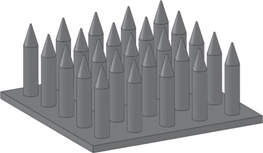Printed Microneedles Could Improve Drug Delivery

Latest News
October 16, 2015
One of the more fascinating areas of 3D printing development in healthcare has been in drug delivery. We’ve written before about efforts to create customized, 3D-printed tablets, implants and other ways to provide more closely calibrated medication dosages. Researchers at the University of Akron and University of Texas have joined the fray with printed microneedles.
The research was published in September in the journal Biofabrication.
According to the researchers, the fabrication technique they’ve developed would offer a pain-free drug delivery device that allows drugs to diffuse within the body as the biomaterial device degraded. Microneedles made of biodegradable polymers would provide a better way to deliver drugs transdermally without the irritation associated with other types of microneedle array materials. The microneedle arrays were designed using 3D CAD software from SOLIDWORKS.
How small is a microneedle? According to the research paper:
A single microneedle body had a cylindrical base of 700 μm in length and a conical tip of 300 μm in length. The diameter of the apex of the cone was 20 μm, whereas the base diameter for cylinder base design was 200 μm. The surface area of each microneedle was 0.58 mm2, and the volume was 0.33 mm3. A microneedle array with 25 individual microneedles had a 2 × 2 mm substrate with a thickness of 300 μm.
The needles were tested and were able to withstand the stresses they would be exposed to when inserted into the skin. Testing showed that the drug was successfully released (a higher initial drug load increased the amount released). Additional work on materials and fabrication techniques could further improve the delivery mechanism.
The biggest challenge for the team was printing the microneedles with the drug used for the tests. The researchers used Dacarbazine, a drug used to treat skin cancer, which was blended into a solution prior to crosslinking. The research noted the challenges related to material viscosity in printing the arrays.
“3D printing this array was difficult, as the printable biomaterial contains some non-printable solvents and drugs,” Jae-Won Choi, a report co-author, told ScienceDaily. “We’d like to have a faster drug release, but this will require more material research. Once we improve this process we can look at developing more controlled drug release. I’d hope we’ll see this being used clinically in five to 10 years.”
Source: ScienceDaily
Subscribe to our FREE magazine, FREE email newsletters or both!
Latest News
About the Author
Brian Albright is the editorial director of Digital Engineering. Contact him at [email protected].
Follow DE





